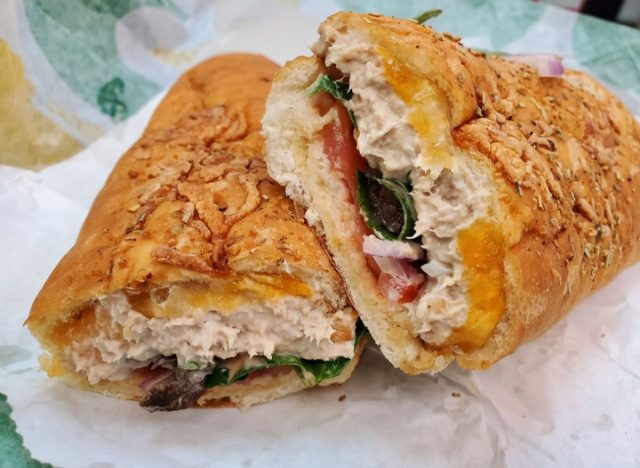America’s Largest Sandwich Chain Is Still Embroiled in This Major Ingredient Lawsuit

Subway has been tweaking its menu for the past year like its survival depends on it. It all started with the Eat Fresh Refresh, which was launched last year and brought several new ingredients and sandwiches to the menu. Most recently, the chain decided to tone down its customization ethos and instead offered up a brand new collection of 12 subs, in the hopes that customers will find the pre-set options easier to navigate.
But behind the scenes, one pesky ingredient is still causing the chain major trouble: the questionable tuna. Likely the most controversial ingredient in Subway’s history, the fish and mayo concoction is at the center of a lawsuit for the second year in a row. First filed in January 2021 and amended several times, the lawsuit alleges the chain is misrepresenting this popular protein as “100% tuna” when what’s found in lab tests is anything but.
This week, a California judge prolonged Subway’s tuna saga by partially rejecting the sandwich giant’s new motion to dismiss the lawsuit, effectively giving the plaintiff an opportunity to prove her claims in court. Customer Nilima Amin, who filed the class-action lawsuit last year, first claimed the chain’s tuna didn’t contain actual tuna DNA. The lawsuit was later amended to highlight new lab findings, which showed the ingredient included chicken, pork, and cattle protein.

While Subway responded to the allegations by saying the protein from other animals came from cross-contamination with other ingredients employees are handling, U.S. District Judge Jon Tigar ruled that its “100% tuna” claim might be inaccurate and misleading to customers.
“Although it is possible that Subway’s explanations are the correct ones, it is also possible that these allegations refer to ingredients that a reasonable consumer would not reasonably expect to find in a tuna product,” Tigar said, according to NBC News.
Subway told various media outlets it was “disappointed the Court felt it couldn’t dismiss the plaintiffs’ reckless and improper lawsuit at this stage. However, we are confident that Subway will prevail when the Court has an opportunity to consider all the evidence.”
When it was first filed in January, the lawsuit was a bombshell. It claimed that the chain’s tuna was “a mixture of various concoctions that do not constitute tuna, yet have been blended together by the defendants to imitate the appearance of tuna.” In fact, the claims went further, stating that a lab test “found that the ingredients were not tuna and not fish,” but no further clarification on what was in Subway’s tuna was provided.
The subsequent independent research by The New York Times seemed to have confirmed the claim that, try as you might, you can’t actually find any traces of tuna in Subway’s tuna. However, deception by Subway was only one possible scenario. Another plausible explanation, according to the report, was that Subway’s tuna is simply too processed to turn up any DNA in lab tests.
And this is exactly the explanation Subway decided to run with. On the section of their website dedicated solely to vindicating its tuna, the chain claims that it’s common to not find tuna DNA in a sample of cooked tuna.
According to an expert Eat This! interviewed on the topic in June, what might be a likely scenario is that Subway is using cheap fish leftovers from fish processing facilities.
“What I believe Subway is doing is they’re using 100% flake from the lines of a very large factory, which is the cheapest byproduct, to get their costs down,” said Sean Wittenberg, cofounder of sustainable seafood company Safe Catch. “And they’re probably doing it from a variety of seafood species—with everything off the line—but I bet the main species that you’re seeing there is skipjack, tongol, and bonito.”
The quality of the tuna and the question about the fish species being passed off as tuna was at the heart of the second iteration of the lawsuit, which was filed last summer. The case was almost put to rest in October when U.S. District Judge Jon S. Tigar dismissed it, saying that the plaintiffs failed to show that they bought the tuna based on the alleged misrepresentation. But, the judge did not rule on the merits of the case, which left room for the lawsuit to be amended yet again.
For now, the legal battle wages on.